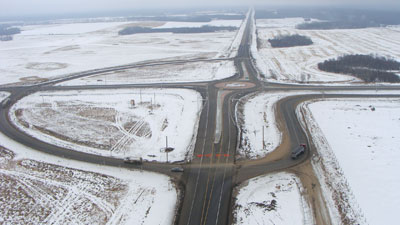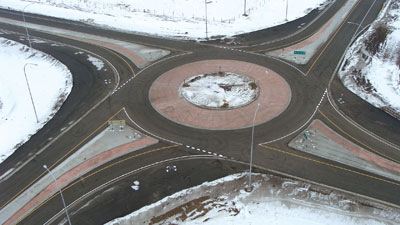
Features
Projects
Roads & Paving
Driving in Circles
Traffic circle solutions in rural Alberta.
April 17, 2013 By Andrew Macklin
With booming business comes booming traffic.
With booming business comes booming traffic. In the Fort McMurray region of Alberta, the growth of the oil, gas and mining sectors has had a significant impact on the road infrastructure across several hundred kilometres of roadway in each direction.
 |
|
| E Construction built bypass roads in order to divert traffic from the construction of the traffic circle.
|
The result of the growth of these industries, and the population increase that has happened along with it, has been a commitment by the Alberta Ministry of Transportation to fund the expansion of the current road network, look for opportunities to add to the region’s road infrastructure and to find new traffic solutions to ensure that all vehicles have the ability to move safely through the region.
Several roadways have been doubled from two lanes to four lanes in order to accommodate the additional volume of vehicles, providing the capacity needed for the increased volume of vehicle traffic.
As the Ministry of Transportation works to increase the capacity of the region’s roadways, a lot of work is being done to figure out the best practices for managing traffic flow through rural intersections. Many just need a two-way stop to control traffic flow, but are in need of new solutions, based on the additional volume as well as shifts in traffic flow through certain areas of the province based on new industry.
Such was the case at the intersection of Highways 55 and 892, located approximately 225 kilometres northeast of Edmonton. Originally, the rural highway intersection near the Saskatchewan border required only stop signs on Highway 892 heading north and south in order to make way for traffic flow west and east along Highway 55. But the intersection now sits in close proximity to the Cold Lake oil sands, a 780-square-kilometre stretch of land owned by Imperial Oil, located just north of the intersection. The result has been an increase in truck traffic, and problems with peak time evening congestion getting through the intersection.
The original process in Alberta would have meant upgrading from a two-way stop to a four-way stop, and then eventually the implementation of a traffic light. However, a new option has now been presented in Alberta that is now in limited use: the modern traffic circle. According to Alberta Ministry of Transportation regulations, any highway intersection where signalization is expected within 10 years must look at traffic circles as a possible traffic flow solution.
The modern traffic circle had been used only three times prior to consideration for the 55/892 project, but had been successful at providing a solid traffic flow solution for difficult intersections, greatly reducing the number of major accidents. After consultation was complete, the decision was made to move forward with a traffic circle.
The $4.6-million project received six bidders, with E Construction eventually securing the project. E Construction already had a long track record of quality road construction work in rural Alberta highways.
 |
|
| The finished traffic circle includes a wide apron in the middle to allow for easier turning radiuses for trucks from the nearby oil refinery.
|
The project presented some design issues that made for a difficult design process. The design had to be able to accommodate 50-foot trailers in order to support the oil tanker trucks that would be passing through the circle each day. In addition to the length of the truck, the wheel movement of the truck also had to be taken into consideration so that it would not be too difficult for drivers to make their way through the circle. Visibility was an issue that also had to be addressed, taking into consideration both the ability of tanker drivers to see smaller cars in the circle, as well as the best places to put signage and reflective materials. There was a question of how to design the centre island so that it was friendly to truck traffic needing an apron in order to swing the trailer through the intersection. In addition to the need for a safe apron for truck tires in the middle of the circle, there also needed to be consideration for curbs that were also mountable, as trucks would need a little more flexibility when turning back on to the highway. By the time the project began, 10 design checks were made.
Another major problem posed by the creation of the traffic circle was, how do you build a new intersection and still allow traffic to flow through?
“We gave the contractor a series of options to consider for traffic accommodation,” said Afzal Piracha, construction engineer for the north-central region for the Alberta ministry of transportation.
“We had discussions with E Construction and, in the end, they chose to isolate the circle in order to keep the traffic away from the construction of the circle.”
That isolation involved building a ring road around the outside of the intersection before work began on the new traffic circle. The road was built off of the westbound traffic flow on Highway 55, east of the traffic circle, moving counter-clockwise to intersect with the northbound Highway 892 lanes, westbound Highway 55 lanes, and southbound Highway 892 lanes. The road was built with a single lane in each direction, with wide rounded curves at each intersection to allow for truck traffic to safely use the road.
Another logistical change that was incorporated was the use of concrete. Alberta’s rural highways are paved with asphalt, but concrete was used in order to construct the centre medians between the lanes for each road, as well as the middle portion of the traffic circle. That presented a challenge for E Construction, who had not previously used concrete as part of its road construction projects.
The traffic isolation measures, addition of the use of concrete, and issues discovered with signage, caused serious delays with the completion of the circle. The original tender specified that the project should be completed within two months’ time. However, the design checks and secondary issues combined to cause the project to take seven months to complete.
As much as the time delays did cause some inconvenience for both the contractor and the motorists using the road, it did provide valuable information for the Ministry of Transportation.
“The challenges presented by the modern traffic circle construction at 55/892 provided us with the information we needed to create a more comprehensive design bulletin,” said Piracha. “As we move forward, incorporating more traffic circles into our roadways across the province, we have a better understanding of what it takes to efficiently use this modern design.”
The lessons learned with the introduction of the modern traffic circle at the 55/892 intersection have already led to a fifth circle planned for Alberta’s highways in 2013.
Print this page